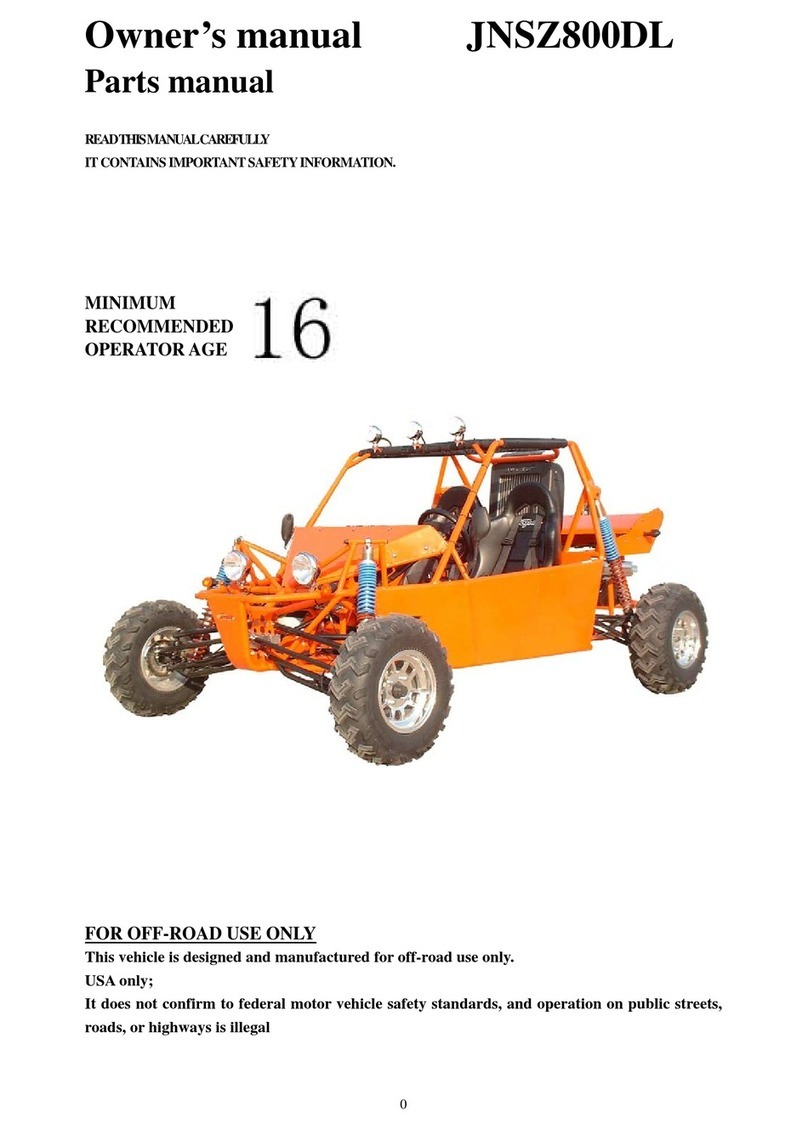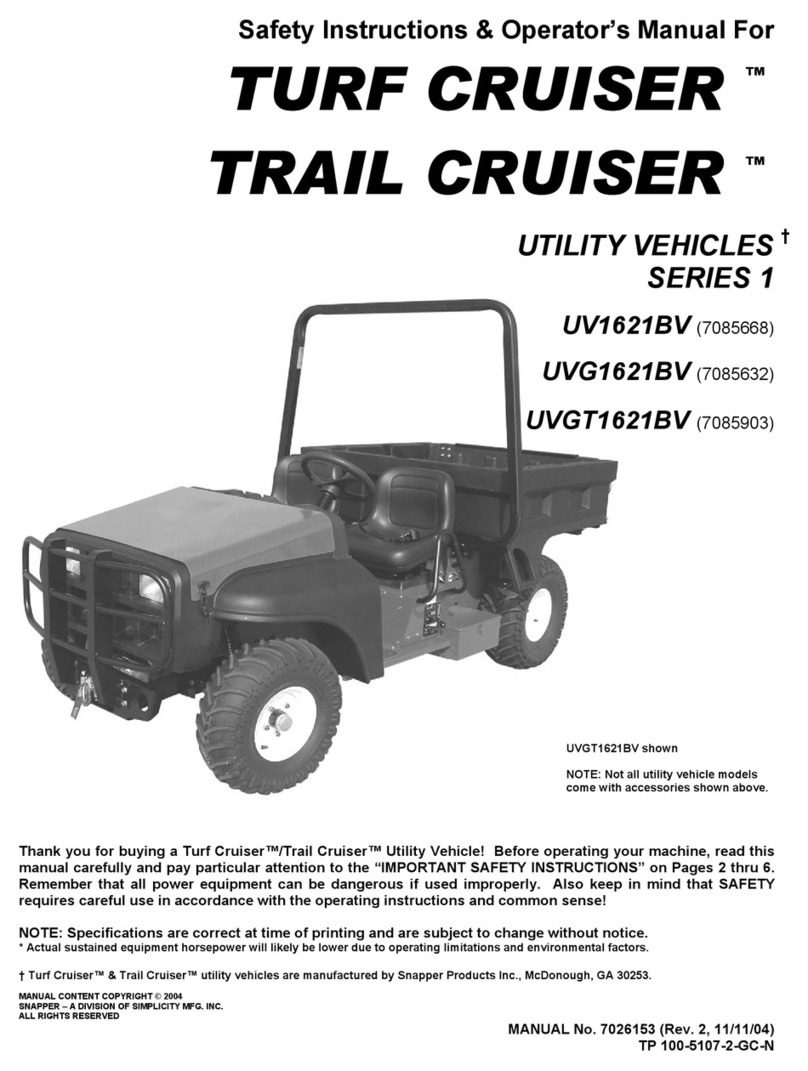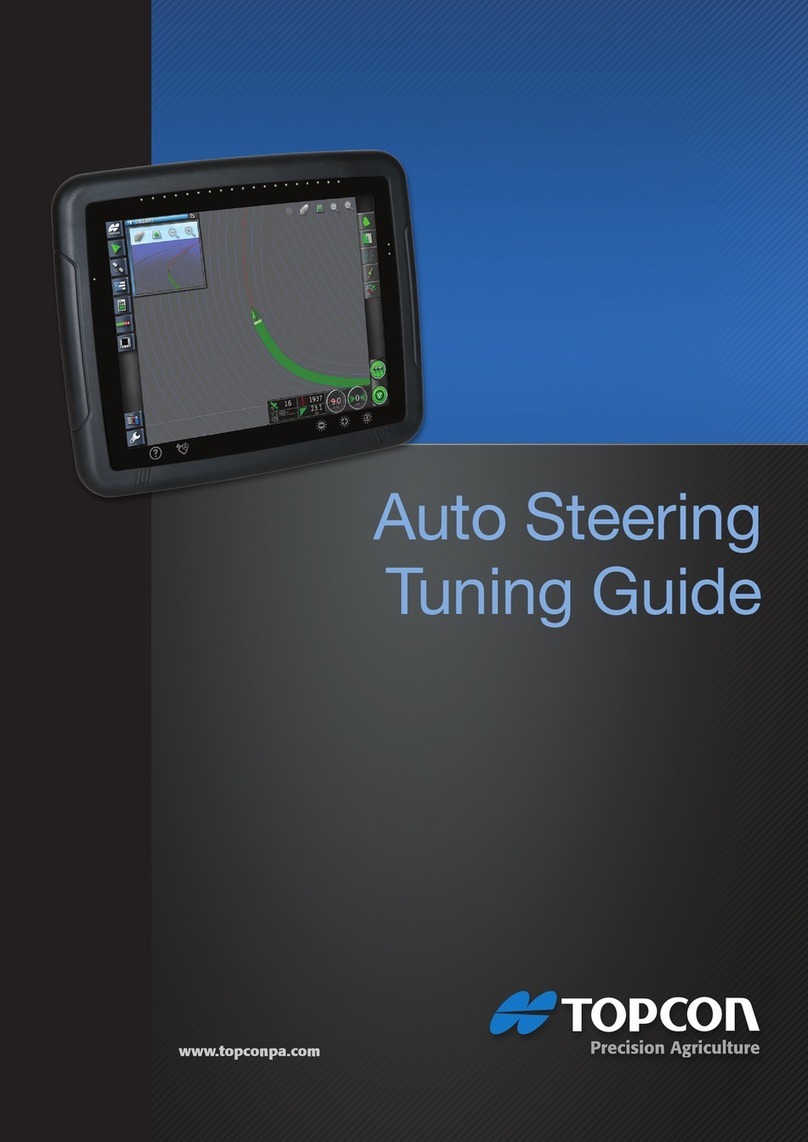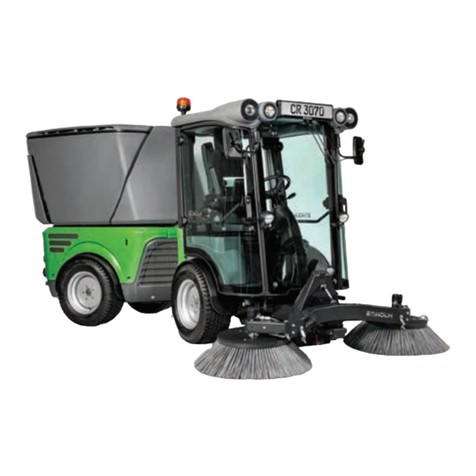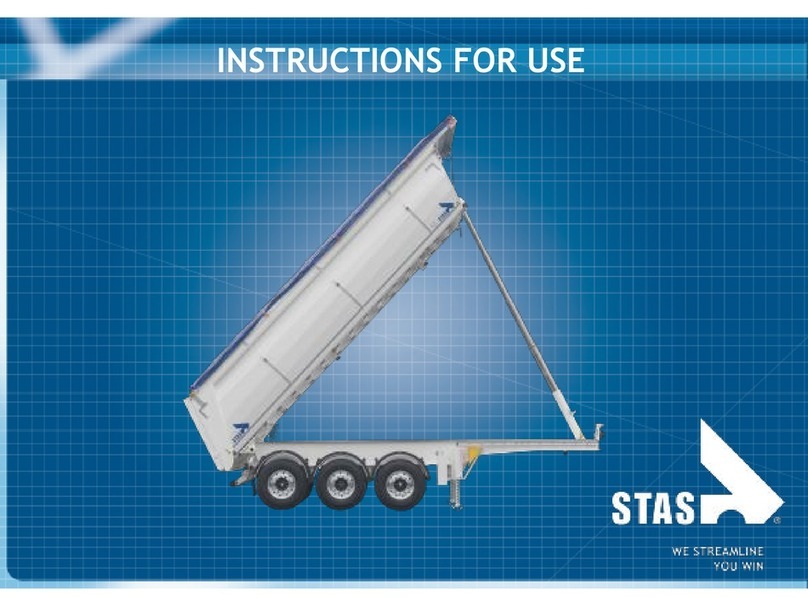Federal Signal Corporation LEACH 2R-III User manual

2R-III
SERVICE MANUAL
Over Serial Number 30000
BUILDING THE BEST
A Subsidiary of Federal Signal Corporation


WARRANTY
RefusebodiesmanufacturedbyLeachCompany,(“Company”)aresuppliedandsoldundera
Limited Warranty that they are and will remain free of defects in workmanship or material for
aperiodofsix(6)monthsfrom the dateoforiginalsaleunderreasonableconditionsofuseand
operation, providing required planned maintenance services are performed. Extended war-
ranty packages are available for purchase. If a failure occurs during said period because of
suchdefectintheopinionoftheCompany, thecomponentorpartshall be repairedorreplaced
by an authorized Leach Distributor at no cost to the customer provided the unit is brought to
the distributor’s service facility. After three (3) months, performance of adjustments or the
replacement of wear/expendable components is not covered under warranty. This limited
warranty is the sole and exclusive warranty of the Leach Company.
THECOMPANYMAKES NO WARRANTYASTOMERCHANTABILITY,FITNESS FOR USE,
LEGALITY OF OPERATION IN ANY JURISDICTION OR ANY IMPLIED WARRANTY OF
ANY KIND OR NATURE. THE COMPANY SHALLNOT BE LIABLE FORANYSPECIALOR
CONSEQUENTIAL DAMAGES OF ANY KIND OR NATURE, OTHER THAN ITS LIMITED
WARRANTY OF REPLACEMENTHEREIN. NO OTHER PERSON, FIRM, OR CORPORA-
TION CAN BIND THE COMPANY TO ANY WARRANTY OTHER THAN HEREIN ABOVE
STATED.
Tovalidate the new unitwarranty,an authorized Leach Distributormusthavecompletedapre-
delivery inspection before the unit is placed into service, and the warranty registration form
signed by both the customer and the distributor must be submitted to the Leach Service De-
partment.
Because Company products are engineered to work only with genuine Company parts, this
limitedwarrantywill be void andof no effect if:(a) Company productsare modified other than
as done at its factory or as authorized to be done by the factory in writing; or (b) Parts or
assemblies of any other manufacturer are used as substitutes for genuine Company parts.
GenuineLeach replacement parts, components andassembliesarealsosoldunder a Limited
Warrantytobe freefromdefectsinworkmanshipor materialfora period ofsix(6) months. This
is a replacement only warranty and the item must be returned to the Leach distributor for
exchange. The labor to replace or repair the part shall be the responsibility of the customer.
There is no warranty on expendable items, wear components or used parts.
Leach Company reserves the right to redesign and/or discontinue the manufacture of parts,
components and assemblies at any time.
A Subsidiary of Federal Signal Corporation
I

FOREWARD
LeachCompanyhas been a leader in the refuse industry for over 115years.Leachrefusebod-
ies are the industry standard for both quality and performance. Leach Company is justifiably
proudofthequalityengineering,materialandworkmanshipthatgoesintoeach andeverypacker
weproduce. Thiscommitmentto qualityextendstothe bestparts,service anddistributororgani-
zationintheindustry.
One area of great importance to us at Leach Company is your safety. This unit was built in
accordancewiththeAmericanNational StandardsInstitute(ANSI)standardforMobile Refuse
CollectionandCompactionEquipment-SafetyRequirements,ANSIZ245.1 - 1999. Before op-
erating this unit please read and understand the safety precautions found in Section 1 of the
Service and Operators manual. They are important and are provided to assist you in the safe
operationof the unit.
This manual was produced with the intention of providing clear, concise instructions for the
proper operation and servicing of your refuse packer. It was produced with the latest informa-
tion available at the time of publication. We do, however, reserve the right to redesign and/or
discontinuethemanufactureofparts, components or assemblies at any time.Leach Company
hasanaggressivemanualandproductimprovementprogram.Inanyconversationorcorrespon-
dencedealing with information provided inanyLeachmanualpleasereferto the part number of
thatmanual.
The manuals provided with the unit are considered a permanent part of the unit and should be
included in the event of a re-sale.Additional manuals are available, free of charge, from your
local authorized Leach distributor. These manuals should be kept readily available for easy
reference. We ask that if you have comments or suggestions concerning this manual please
contactus at (877)800-1111.Weare here to beof service toyou, our valuedcustomers.
II

III
TABLE OF CONTENTS
WARRANTY..................................................................I
FORWARD....................................................................II
TABLE OF CONTENTS..............................................III
SECTION 1 - SAFETY PRECAUTIONS
General................................................................1-1
Danger, Warningand CautionDecals......................1-1
Prior To Start Up...................................................1-2
General Operation.................................................1-3
Hydraulics............................................................1-5
Fire Protection......................................................1-5
Housekeeping.......................................................1-5
Shutdown.............................................................1-5
Decal Locations....................................................1-6
SECTION 2 - INTRODUCTION
Terms You Will Need To Know................................2-1
Loading................................................................2-2
Compaction..........................................................2-2
Unloading.............................................................2-3
ContainerAttachment(Latchand Ears)...................2-4
Container Handling Systems.................................2-4
General................................................................2-5
Terms You Will Need To Know................................2-5
Hook........................................................2-5
Container..................................................2-5
Container Attachment................................2-5
Winch......................................................2-6
ContainerLiftingCylinder (CLC)..................2-6
Container Push Bar (CPB).........................2-6
Basic Operation....................................................2-7
Attach......................................................2-7
Dump.......................................................2-7
Dosconnect..............................................2-7
SECTION 3 - OPERATION
General................................................................3-1
Description of Operating Controls...........................3-1
Location of Operating Controls...............................3-2
Pump/PTO Control....................................3-3
Speed-Up Toggle Switch............................3-3
Tailgate Open Light...................................3-3
EngineSpeed-UpPush Button...................3-4
Front Control Valve...................................3-4
Push Out Lever.........................................3-4
Tailgate Lift Lever......................................3-4
Tailgate Clamps........................................3-4
Driver Signal Buttons................................3-5
PackerandCarrierPanelControlLevers......3-5
Compaction Cycle Operation.....................3-5
ContainerHandlingControl Levers..............3-5
Operating Procedures............................................3-6
Pre-OperatingWalkAround Inspection....................3-6
WalkAround Inspection Check List.......................3-10
Start Up (Operating Instructions)............................3-11
Positioning the Pushout Panel..............................3-12
Loadingthe Hopper...............................................3-13
SECTION 3 - OPERATION (continued)
Attaching a Container to The Packer.....................3-13
Usinga Winchor ContainerLiftCylinder................3-14
Using a Container Push Bar..................................3-15
Packing The Load.................................................3-15
PushoutPanel OperationDuring Packing..............3-16
DisconnectingTheContainer.................................3-16
UnloadingAt Dumpsite..........................................3-17
Lifting The Tailgate................................................3-17
Ejecting The Load.................................................3-18
LoweringTheTailgate............................................3-18
Shut Down...........................................................3-19
SECTION 4 - GENERAL REPAIR PRACTICES
Preparation For Service.........................................4-1
Replacement Parts...............................................4-1
Technical Service Bulletins....................................4-1
SafetyPrecautions Prior to Service orRepair...........4-2
SafetyDuring ServiceAndRepair............................4-2
Welding Precautions.............................................4-2
Oxy-Acetylene Torches.........................................4-3
Reassembly And Installation..................................4-4
Electrical Testing..................................................4-4
Checking For Voltage................................4-4
Checking Continuity..................................4-4
Welding................................................................4-4
Lifting Instructions.................................................4-5
Capacity of Lifting Device.......................................4-5
Sling Strap Specifications......................................4-5
ChainAndHardware Specifications.........................4-5
CapscrewMarkingAndTorque Values.....................4-6
Hydraulic Fitting Torque Values..............................4-7
SECTION 5 - SPECIFICATIONS
Body Specification Chart.......................................5-1
Lubricants.............................................................5-2
Hydraulic System.................................................5-2
Pump...................................................................5-2
Hydraulic Fluid Recommendation...........................5-2
SECTION 6 - PREVENTIVE MAINTENANCE
General................................................................6-1
Operatingand Maintenance Records......................6-1
Lubrication Chart...................................................6-2
Hydraulic System Service.....................................6-5
Checking Fluid Level.................................6-5
Clean Tank Breather..................................6-5
Check/ReplaceReturn Line Filter...............6-5
Flushing Hydraulic System........................6-5
Contamination.......................................................6-7
Commercial Hydraulic Fluid Testing........................6-7
In House Hydraulic Fluid Testing.............................6-7
PreventiveMaintenanceRequirements....................6-8
Daily Preventive Maintenance................................6-8
WeeklyPreventive Maintenance.............................6-9
MonthlyPreventiveMaintenance............................6-10
Yearly Preventive Maintenance...............................6-10

IV
TABLE OF CONTENTS
SECTION 7 - CHECK-OUT
General................................................................7-1
Check Hydraulic Tank Fluid Level...........................7-1
CheckEngine Speed-Up Switch (Cab)....................7-2
CheckEngine Speed-UpSwitches (Body)...............7-2
Check Pack Cycle Time........................................7-3
Check Pressures..................................................7-3
Check Main Line Pressure.....................................7-4
CheckPackerAndCarrierPanelShiftPressures......7-5
Check Resistance Cartridge Pressure....................7-6
CheckPackerPanel High Pressure(Circuit)Relief...7-7
CheckAccessory (Circuit) Relief Pressure..............7-8
Check Pushout Panel Shoes.................................7-9
Check Power Take Off (PTO)..................................7-9
SECTION 8 - TROUBLESHOOTING
General................................................................8-1
Compaction..........................................................8-1
Dieseling In Hydraulic System...............................8-2
Operation Is Erratic...............................................8-3
Pump Noise Is Excessive......................................8-3
EngineWill Not Speed Up When Carrier PanelLever or
Speed Up Button Is Engaged.................................8-4
EngineSpeedUpWillNotReturnToNormalWhenPack-
ing Cycle Is Complete or Speed Up Button Is Re-
leased..................................................................8-4
PackerPanel Valve SectionShiftsToo Slow.............8-4
Carrier Panel Valve Section Shifts To Neutral Too
Soon....................................................................8-5
PackerPanel Valve Section Will Not Shift................8-5
CarrierPanelValve Section WillNotShiftTo Neutral.8-5
Packer/CarrierPanelsDoNotDeliverFullForceToPack
Load Into Body.....................................................8-5
LoudSquealing NoiseWhen ManuallyRetractingTele-
scopic Cylinder.....................................................8-6
Load Will Not Push Out.........................................8-6
Pushout Panel Slides Forward Too Fast While Packing
Refuse..................................................................8-6
PushoutPanelWill Not SlideForwardAutomatically.8-6
CarrierAnd Packer PanelsStopShortOfHomePosition
After Each Cycle..................................................8-6
Packer Panel Drifts Open While Packing Load Into
Body....................................................................8-7
Cycle Time Too Slow.............................................8-7
Tailgate Will Not Raise..........................................8-7
Container Won’t Lift..............................................8-8
Winch Motor Leaking............................................8-8
Container Raises Very Slowly................................8-8
Description Of Hydraulic System............................8-9
System Component Nomenclature.........................8-9
Neutral.................................................................8-10
PackerPanel SweepsBackOver Load..................8-11
CarrierAnd Packer Panels Move Down To Interrupted
Cycle Position......................................................8-12
PackerPanel SweepsHopper...............................8-13
Packing Refuse....................................................8-14
Raising Tailgate....................................................8-15
SECTION 8 Continued
Ejecting Load.......................................................8-17
Retracting Pushout Panel.....................................8-18
LoweringTailgate..................................................8-19
SECTION 9 - SERVICE AND REPAIR
General................................................................9-1
Description Of Operating Cylinders.........................9-1
Test For Leaking Packer Panel Cylinders................9-2
Test For Leaking Carrier Panel Cylinders.................9-4
RemovalOf PackerPanel Cylinders........................9-7
RemovalOf CarrierPanel Cylinders........................9-9
DisassemblyOf Operating Cylinders......................9-11
Reassembly And Installation Of Operating Cylin-
ders.....................................................................9-12
Description Of Packer Panel.................................9-12
BearingReplacement............................................9-12
RollerReplacement/Shimming...............................9-13
Description Of Tailgate Lift Cylinders.....................9-15
TestFor LeakingTailgateLiftCylinders..................9-15
RemovalOfTailgate LiftCylinders.........................9-16
DisassemblyOfTailgate Lift Cylinder.....................9-17
Inspection,ReassemblyAndInstallationOfTailgateLift
Cylinders..............................................................9-17
DescriptionOfTailgateAssembly...........................9-18
RemovalOfTailgateAssembly...............................9-18
InspectionOfTailgate............................................9-19
ReassemblyAnd InstallationOfTailgate................9-19
Front Control Valve...............................................9-20
Removal Of Front Control Valve............................9-20
Disassembly And Inspection Of Front Control
Valve....................................................................9-20
ReassemblyOf FrontControl Valve.......................9-21
ReinstallationOf Front Control Valve......................9-22
Main Control Valve................................................9-23
RemovalOf MainControl Valve.............................9-24
DisassemblyAnd Inspection Of MainControlValve.9-25
ReassemblyOf Main Control Valve........................9-25
RemovalOfTelescopic Cylinder.............................9-26
Telescopic CylinderPacking Replacement.............9-27
Telescopic CylinderDisassembly...........................9-28
Description Of Pushout Panel...............................9-29
WearBlock Replacement......................................9-29
Removal Of Pushout Panel...................................9-30
Installation Of Pushout Panel................................9-31
DescriptionOf CarrierAnd Packer Panels..............9-32
Removal Of Packer Panel.....................................9-33
InspectionAndReplacement Of PackerPanel........9-34
ReplacementOf Packer Edge...............................9-35
Installation Of Packer Panel..................................9-35
Carrier Panel........................................................9-36
RemovalOf CarrierPanel......................................9-36
InspectionAnd ReplacementOfCarrier Panel........9-37
InstallationOf CarrierPanel...................................9-37
TrackBar Replacement.........................................9-37
DescriptionOf HydraulicPump..............................9-38
RemovalOf HydraulicPump..................................9-38

V
TABLE OF CONTENTS
SECTION 9 Continued
Installation Of Hydraulic Pump..............................9-39
New Pump Preparation.........................................9-39
Testing A New Pump............................................9-39
Description Of Electrical System...........................9-40
Testing.................................................................9-40
Repair...................................................................9-40
Inspection.............................................................9-40
Schematics..........................................................9-40
SECTION 10 - SERVICE TOOLS
Service Tools......................................................10-1


GENERAL
The2R-III hasbeendesigned with theoperatorinmind.
However, as with any industrial machinery, especially
those that are large and apply forces through hydraulic
pressures,theultimateresponsibilityforsafetyrestswith
you - the user. An alert, conscientious attitude and ob-
servance of all known safe operating practices are the
best ways to prevent accidents.
Before operating the unit, it is the operator’s responsi-
bilityto be thoroughly familiar with the instructions con-
tained in the Operator’s Manual.
SAFETY PRECAUTIONS
Publication of these precautions does not imply or in
any way represent an all inclusive list. It is the opera-
tors responsibility to be familiar with and ensure that
operationisinaccordance with safetyrequirementsand
codes including all applicable Occupational Safety &
Health Act (OSHA) and American National Standards
Institute (ANSI) regulations.
DANGER, WARNINGAND CAUTION
DECALS
See the accompanying illustration for the location and
label content of all safety decals.
1. These decals must be obeyed at all times.
2. These decals must be in place at all times. Report
any damaged or missing decals to the proper
authority at once.
3. Replacement decals can be ordered free of charge
from your local authorized Leach distributor.
DANGER, WARNING AND CAUTION
Throughout this manual “DANGER” “WARNING” and “CAUTION” notations accompanied by the International
Hazard Symbol are used to alert the operator and mechanics to special instructions concerning a particular
operation or service that may be hazardous if performed incorrectly or carelessly.
DANGER - Immediate haz-
ards which WILL result in
severe personal injury or
death
WARNING - Hazards or
unsafe practices which
COULD result in severe
personal injury or death.
CAUTION - Hazards or un-
safepracticeswhichcould
result in minor personal
injury or property or prod-
uct damage.
Strict compliance to these “safety alerts” combined with “common sence” operations are important accident
prevention measures.
The word NOTE is also used throughout the manual. It precedes information that provides special emphasis or
clarification on a specific operation or procedure.
SECTION 1
1-1

SECTION 1
SAFETY PRECAUTIONS
PRIOR TO START UP
Never operate machinery while wearing jewelry or
looseclothing.These items may become caught by
or entangled in the machinery causing serious in-
jury. Wear proper safety equipment as required by
youremployer.
Never operate machinery while under the influence
of alcohol, narcotics or other mood altering sub-
stances.Workerswhooperate machinery while un-
der the influence are a hazard to themselves and
others.
Perform a pre-operation “walk around” inspection
of the truck chassis in accordance with the chassis
manufacturer’s guidelines. Perform a “walk around”
inspection of the refuse packer in accordance with
thechecks listedin Section 3 - Operationof the Op-
erators/Service manual. Never start or operate any
equipment found to have malfunctions.
1.
2.
3.
Report any malfunctions immediately to the
properauthorities.
Priortoleavinganymalfunctioningunitthepark-
ing brakes must be set, the PTO system
disengaged, the engine turned off, the ignition
key removed, and using a non-reusable fas-
teningdevice,placeasignonthesteeringwheel
indicating the unit is inoperative.
a.
b.
Properservicing requires specialized tools andpro-
cedures. Service must be performed by authorized
personnel only following procedures in the 2RIII
Service manual.
4.
Walk completely around the vehicle to make sure
allpersons and obstructions are clearbefore start-
ing the unit.
Thecontainerhandling systemis a critical compo-
nent of the unit. Use only the proper replacement
parts.
Inspect all hooks, chains and cables daily to en-
sure serviceable condition. Replace damaged or
worn parts. (See Section 5, Preventive Mainte-
nance)
Before operating the vehicle the driver must be
thoroughly familiar with the employer’s safety pro-
gramconcerning trafficrules, warning devicesand
hand signals.
Be sure to know where to get assistance in the
event of an emergency.
Know your machine. Know the location and func-
tion of all controls, gauges, instruments and pro-
tective devices.
Should the height of a refuse collection vehicle be
altered by installing a container handling system,
besure theoverall height is rechecked and overall
height plus 3 inches is noted on the decals.
5.
6.
7.
8.
9.
10.
11.
1-2

SECTION 1
SAFETY PRECAUTIONS
GENERAL OPERATION
It is the operator’s responsibility to ensure that op-
eration of the unit is in accordance with the guide-
lines contained in the Operator’s manual and in ac-
cordance with all applicable codes including Occu-
pational Safety and HealthAct (OSHA) and Ameri-
canNationalStandardsInstitute (ANSI) regulations.
Do not attempt to operate this equipment without
proper training.
Movethe vehicle asslowly aspossible without stall-
ing when traveling in reverse.
Always make sure the area behind the unit is clear
before traveling in reverse.
Do not travel in reverse for distances greater than
those dictated by local ordinances. If reverse travel
exceeds 10 feet, use a “spotter” or move the ve-
hicle in 10 foot increments only, and then check to
makesure the area behind theunit isclear between
increments.
Donot attempt todislodge any materialabove waist
level unless wearing eye protection such as “ap-
proved” side shielded safety glasses or a full face
shield.
Never use the unit to push or tow another vehicle.
Never unload uphill or against a pile of refuse or
into the bank of a hill.
Never place head, body, fingers or any limbs into a
scissors point or pinch point on the equipment.
Before operating the vehicle the driver must be
thoroughlyfamiliarwiththeemployer’ssafetyprogram
concerning traffic rules, warning devices and hand
signals.
Know where to get assistance in the event of an
emergency.
Know your machine. Know the location and func-
tionof allcontrols, gauges, instruments and protec-
tive devices.
Wear your seat belt.
Start the engine following the manufacturer’s rec-
ommended procedure.
Always set the park brake before leaving the cab.
1.
2.
3.
4.
5.
6.
7.
8.
9.
10.
11.
12.
13.
14.
Turn on appropriate warning lights, put on a safety
vest, protective glasses and protective shoes.
All service opening covers and access doors must
bemaintainedand latchedin placewhile operating
equipment.
Ensure all co-workers are in view before operating
or moving any controls or the unit.
Ensure that there is sufficient overhead clearance
before operating the unit.
Rideonlyin thecabor onriding platforms designed
for that purpose. Riding steps shall not be used
when speeds are expected to exceed 10 mph or
whendistancetraveledwithoutstoppingwillexceed
2/10 of one mile. Do not mount or dismount riding
step when vehicle is in motion.
Never allow anyone to ride on the steps when the
vehicle is backing up.
Stop the vehicle immediately if warning lights for
the TAILGATEAJAR system come on.
Never use controls or hoses for hand holds when
mounting or dismounting. Controls and hoses are
movable. They do not provide proper support and
may cause accidental equipment movement.
Make sure the backup alarm is working properly.
Alwaysensurethatallpersonsareclearbeforerais-
ing or lowering the tailgate. It is the operator’s re-
sponsibilitytowarn all personsnotto standor cross
under a raised tailgate.
Do not move the vehicle with the tailgate raised
exceptduring unloading andthen only asnecessary
to clear the load before lowering.
Standclear whenthe tailgate isbeing raised orlow-
ered and during the unloading cycle. If it is neces-
sary to manually clear the debris from the hopper,
use a long metal probe and DO NOT stand under
the tailgate.
Never load the hopper above the loading sill.
Never allow material to extend outside of the hop-
per when packing.
Allow the packer panel control lever and carrier
panel control lever to shift automatically.
15.
16.
17.
18.
19.
20.
21.
22.
23.
24.
25.
26.
27.
28.
29.
30.
1-3

1-4
SECTION 1
SAFETY PRECAUTIONS
To avoid possible bodily injury or equipment dam-
age, lower the tailgate slowly.
Never enter the body unless the telescopic ejec-
tioncylinderpressure is released,PTOdisengaged
andignitionkeyremovedandplacedin your pocket.
Do not attempt to load refuse into the hopper after
the packing cycle has begun. The packer panel
must be in the “home” position and stopped before
loading the hopper.
The dashboard speed-up switch must be “OFF”
between pickups or when parked. This prevents
inadvertent engine speed-up if the tailgate carrier
panel control lever is shifted.
The tailgate clamps must be tightened securely
before starting to load.
Do not step on the throttle pedal while the speed-
up system is engaged.
Never use a rear loader to transport a container.
Followall safetydirections listed in the refuse body
OperatorandServicemanual under SAFETYPRE-
CAUTIONS.
Never use container handling chains or cable for
towing or pulling.
When not handling containers, keep the container
attachment closed or latched.
Do not operate the rear loader’s packing mecha-
nism with a container off the ground.
If it is necessary to manually free debris from the
container, use a long metal probe while the con-
tainer is on the ground, and DO NOT place your-
self between the container and the packer body.
Attach hook to the tailgate and take up the excess
slack when not in use.
Never hold the hook on an attachment point while
taking up slack.
Take up excess cable slack before moving the ve-
hicle.
Check overhead clearance before dumping a con-
tainer.
31.
32.
33.
34.
35.
36.
37.
38.
39.
40.
41.
42.
43.
44.
45.
46.
Donot move thevehicle with acontainer attached.
Alwaysset thevehicle parking brake before attach-
ing or lifting a container.
Never lift a container which is non-compatible with
the Leach container attachment.
Neverlifta containerwithout firstlatching both con-
tainer latch arms.
Raisethecontainerwithasmooth even movement.
Do not bounce the container.
Do not slam the container against the packer tail-
gate or bump bar.
Do not attach the hook to any lift point which will
not be completely encircled by the hook with the
safetylatch closed. Do not remove the hooksafety
latch.
Read and obey all container decals issued by the
container manufacturer.
Readand follow containermanufacturers informa-
tion on accepted use practices.
Do not attempt to lift overloaded containers.
Center the container on the attachment.
All containers should be inspected for serviceabil-
ity and repaired if not in safe, usable condition.
Donot usenon-standardor damagedtrunnion bar.
Never cross under a raised container.
Stand clear when dumping containers.
Before attempting to lift a container, below 32 de-
grees F (0 degrees C) make sure it is not frozen to
the ground.
Whenusinganeyetypecontainerattachmentpoint,
the base of the hook must be positioned to lift on
the inside of the eye.
Place the container on a flat, level surface.
47.
48.
49.
50.
51.
52.
53.
54.
55.
56.
57.
58.
59.
60.
61.
62.
63.
64.

SECTION 1
SAFETY PRECAUTIONS
HYDRAULICS
Hydraulic fluid operates under high temperatures.
Avoid contactwithpiping,hoses orcylinders to pre-
vent burns.
Neveruse hands to check for leaks. Hydraulic fluid
escaping under pressure may cause injury.
1.
2.
Incase ofinjury seekproper medicaltreatment im-
mediately.
3.
FIRE PROTECTION
Keep a fire extinguisher accessible at all times, as
recommended by the Bureau of Motor Carrier
Safety.
Never use lighted smoking materials, open flame
or sparks around when working with flammable
materials such as fuel tanks or storage batteries.
Never have an open flame as a light source.
Never load ashes or other materials which might
besmoldering.These materials could ignite refuse
in the packer body.
1.
2.
3.
4.
HOUSEKEEPING
Good housekeeping habits are a major factor in acci-
dentprevention.
Keep handrails and steps clean and free of grease
or debris.
Donotstorebrooms or otherequipmentwhere they
could inadvertently activate the packer controls.
1.
2.
Rubbish,scrap paperand litterare highlycombus-
tible. Such material should be stored in metal con-
tainers entirely clear of sparks and flames.
3.
SHUTDOWN
Put all controls in neutral.
Set parking brake.
Disengage PTO.
Shut off engine.
Shut off solenoid dashboard switch.
Remove key.
Lock vehicle.
1.
2.
3.
4.
5.
6.
7.
1-5

1-6
SAFETY PRECAUTIONS - DECAL PLACEMENT
SECTION 1
1
4
2
5
6
3
7
89
10
7
7
9
1
8452610
1
3
CART TIPPER
CONTROL
DOWN
UP
DOWN UP

SAFETY PRECAUTIONS - DECAL PLACEMENT
SECTION 1
2
1
3
45
12
3
4
5
CART TIPPER
CONTROL
DOWN
UP
DOWN UP
1-7

SAFETY PRECAUTIONS - DECAL PLACEMENT
SECTION 1
1234
5
6
7
8910
1-8
74 9
10 13 15 16 18
19
8
20 21 22
14 23
11
2 3
117 512
24
6

SECTION 1
SAFETY PRECAUTIONS - DECAL PLACEMENT
1-9
22
11 12
13
14
15
16
17
18
20
21
23
19
4.
ENGAGE TAILGATE PROPS B
3.
1.) SLIDE TG PROP ALL OF THE WAY OUT UNTIL IT REACHES THE STOP.
2.) LIFT THE PROP INTO POSITION.
3.) REINSTALL PROP RETAINER PIN AND CLEVIS.
4.) LOWER TAILGATE SLOWLY AGAINST BOTH PROPS.
*INSPECT BOTH PROPS TO ENSURE THAT THEY ARE PROPERLY ENGAGED.
2.
1.
3.
DISENGAGE TAILGATE PROPS B
1.
2.
1.) SWING TG PROP ALL OF THE WAY IN UNTIL IT REACHES THE STOP.
2.) REINSTALL PROP RETAINER PIN AND CLEVIS.
3.) LOWER TAILGATE SLOWLY AND LATCH TAILGATE CLOSED.
1.
DISENGAGE TAILGATE PROPS A
1.) RAISE TAILGATE SLOWLY UNTIL PROPS ARE NO LONGER SUPPORTING TAILGATE.
2.) REMOVE CLEVIS HOLDING PROP RETAINER IN PLACE.
3.) REMOVE THE PROP RETAINER PIN AND SWING THE PROP INTO STORAGE POSITION.
2.
3.
3.
1.
ENGAGE TAILGATE PROPS A
2.
3.
1.) UNLATCH TAILGATE, RAISE TAILGATE SLOWLY UNTIL ENOUGH ROOM IS AVAILABLE TO DEPLOY PROPS.
2.) REMOVE THE CLEVIS HOLDING THE PROP RETAINER PIN IN PLACE.
3.) REMOVE THE PROP RETAINER PIN.
ENGAGE BOTH TAILGATE PROPS BEFORE ENTERING UNDER TAILGATE
!WARNING
TAILGATE PROP OPERATION INSTRUCTIONS
706254
3.
2.
24

4
56
7
16
8
12
15
20
21
28
43
30
44
39
SECTION 1
SAFETY PRECAUTIONS - DECAL PLACEMENT
1-10
5815 416 39 621 34 44
44
28 24 7
20 30 43
4.
ENGAGE TAILGATE PROPS B
3.
1.) SLIDE TG PROP ALL OF THE WAY OUT UNTIL IT REACHES THE STOP.
2.) LIFT THE PROP INTO POSITION.
3.) REINSTALL PROP RETAINER PIN AND CLEVIS.
4.) LOWER TAILGATE SLOWLY AGAINST BOTH PROPS.
*INSPECT BOTH PROPS TO ENSURE THAT THEY ARE PROPERLY ENGAGED.
2.
1.
3.
DISENGAGE TAILGATE PROPS B
1.
2.
1.) SWING TG PROP ALL OF THE WAY IN UNTIL IT REACHES THE STOP.
2.) REINSTALL PROP RETAINER PIN AND CLEVIS.
3.) LOWER TAILGATE SLOWLY AND LATCH TAILGATE CLOSED.
1.
DISENGAGE TAILGATE PROPS A
1.) RAISE TAILGATE SLOWLY UNTIL PROPS ARE NO LONGER SUPPORTING TAILGATE.
2.) REMOVE CLEVIS HOLDING PROP RETAINER IN PLACE.
3.) REMOVE THE PROP RETAINER PIN AND SWING THE PROP INTO STORAGE POSITION.
2.
3.
3.
1.
ENGAGE TAILGATE PROPS A
2.
3.
1.) UNLATCH TAILGATE, RAISE TAILGATE SLOWLY UNTIL ENOUGH ROOM IS AVAILABLE TO DEPLOY PROPS.
2.) REMOVE THE CLEVIS HOLDING THE PROP RETAINER PIN IN PLACE.
3.) REMOVE THE PROP RETAINER PIN.
ENGAGE BOTH TAILGATE PROPS BEFORE ENTERING UNDER TAILGATE
!WARNING
TAILGATE PROP OPERATION INSTRUCTIONS
706254
3.
2.
24

SECTION 2
INTRODUCTION
2-1
TERMS YOU WILL NEED TO KNOW
TAILGATE
ASSEMBLY
BODY
ASSEMBLY
HOPPER
LOADING
EDGE
HYDRAULIC
TANK
PUSHOUT
PANEL
CARRIER
PANEL
PACKER
PANEL

SECTION 1
2-2
INTRODUCTION
The main purpose of the 2R-III is to safely and effi-
ciently:load,compact,transportand unload refuse.The
following describes how the unit performs those tasks
in the most basic terms. For a more detailed descrip-
tion of the unit and its components, read the complete
2R-III SERVICE MANUAL. Before going further, look
at the accompanying full page illustration of the 2R-III
and become familiar with the terms you will need to
know.
LOADING
Refuse is first loaded into the hopper of the tailgate
assembly.Thecarrier and packer panels,which sweep
up and pack the refuse from the hopper, will be in the
“home” position.
"HOME" POSITION
CARRIER
PANEL
PACKER
PANEL
COMPACTION
When the operator starts the packing cycle the carrier
and packer panels move rearward, over the load.
CARRIER AND PACKER PANELS MOVE OVER LOAD
Next,the carrier and packerpanelautomatically stopat
the “interrupted cycle” position.
PACKER
PANEL
CARRIER
PANEL
“INTERRUPTED CYCLE”
Table of contents
Popular Utility Vehicle manuals by other brands

Club Car
Club Car Carryall 272 2004 owner's manual
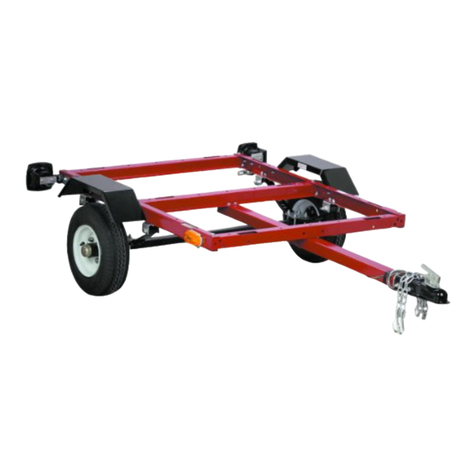
HAUL MASTER
HAUL MASTER 42708 owner's manual
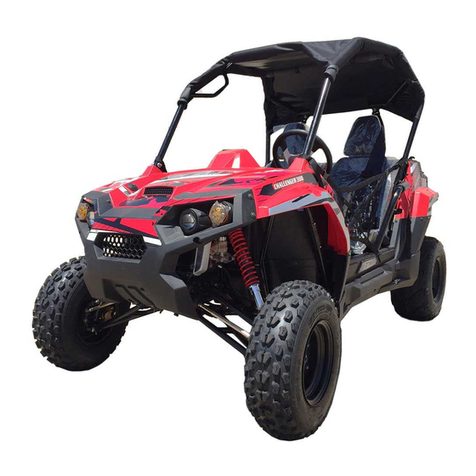
TrailMaster
TrailMaster Challenger 300UTV-X Setup Instruction
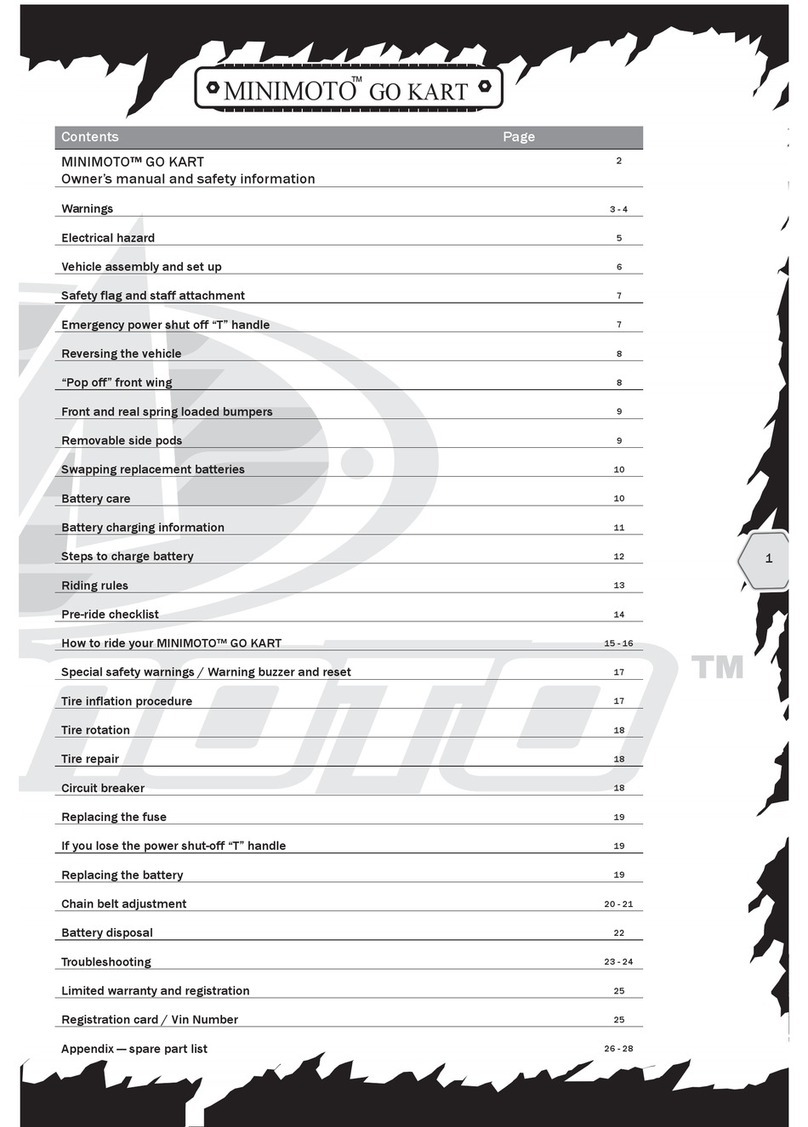
MINIMOTO
MINIMOTO GO CART Owner's manual and safety information
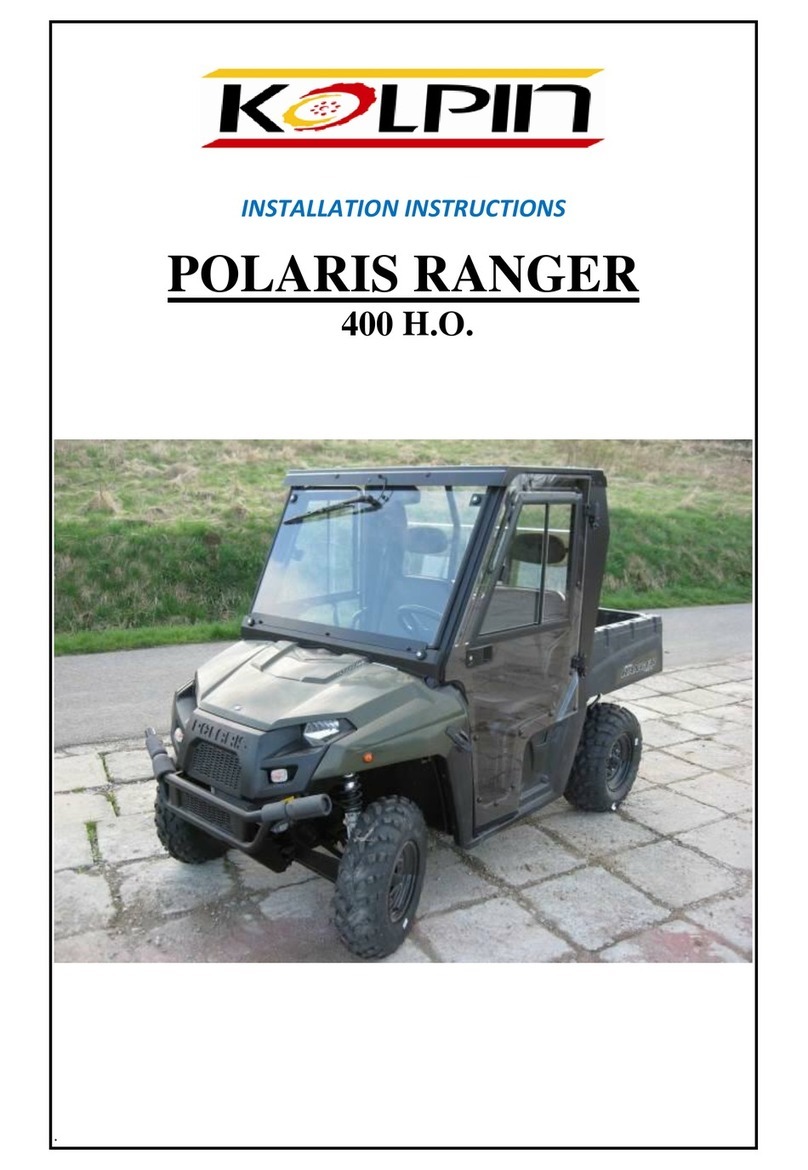
Kolpin
Kolpin POLARIS RANGER installation instructions
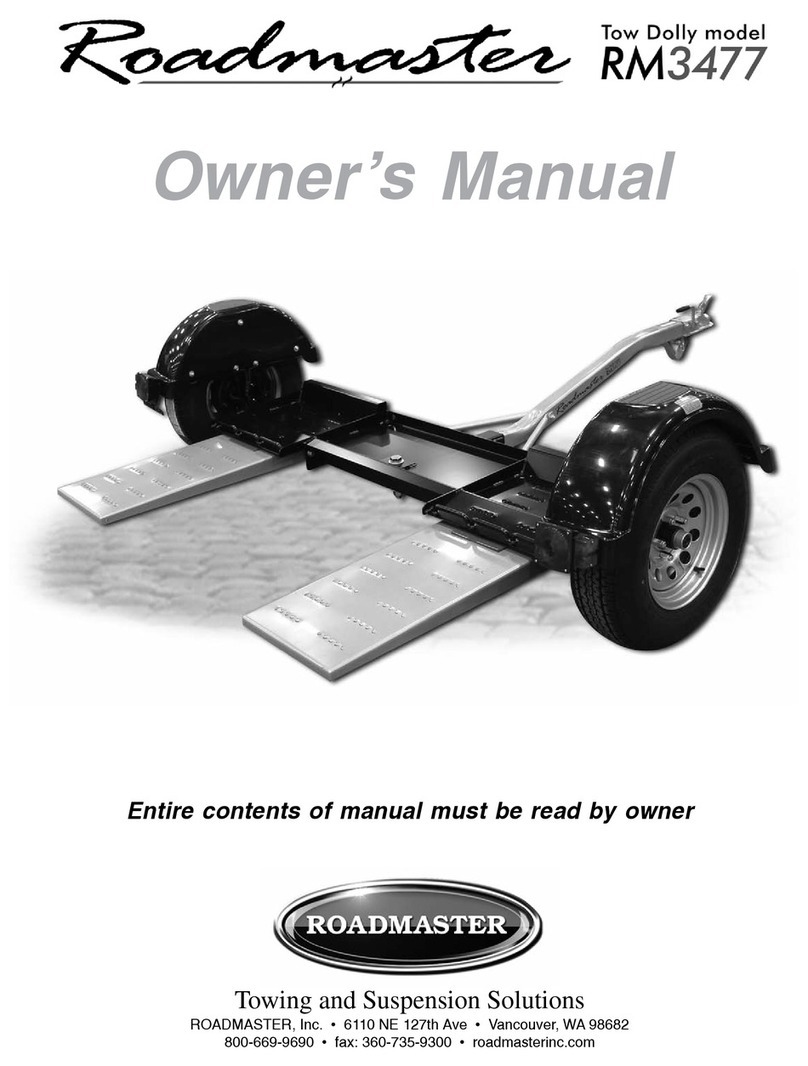
Roadmaster
Roadmaster Tow Dolly RM3477 owner's manual
